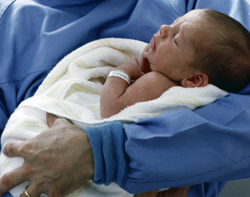Newborns with respiratory distress should be evaluated for primary ciliary dyskinesia, a rare genetic disease that has features similar to cystic fibrosis, says Thomas Ferkol, M.D., from Washington University School of Medicine in St. Louis. He reports finding that about 80 percent of patients with primary ciliary dyskinesia (PCD) have a history of newborn respiratory distress.
 |
|
Thomas Ferkol talks about primary ciliary dyskinesia.
|
“The diagnosis of PCD requires a high index of suspicion, but PCD must be considered in any term newborn who develops respiratory distress or persistent hypoxemia (low oxygen in the blood), especially those who have reversed internal organs or an affected sibling,” says Ferkol, director of the Division of Pediatric Allergy and Pulmonary Medicine at Washington University School of Medicine and St. Louis Children’s Hospital.
Reviewing published reports, Ferkol and Margaret Leigh, M.D., professor of pediatrics at the University of North Carolina at Chapel Hill (UNC), found that neonatal respiratory distress was a common clinical symptom of PCD, a chronic airway disease that affects about 1 in 15,000 children. Their findings appeared in the December issue of Seminars in Perinatology.

Ferkol, also associate professor of pediatrics and of cell biology and physiology and director of the Cystic Fibrosis Center at Washington University School of Medicine, is leading the Washington University research team that is part of a national consortium investigating the genetic causes of PCD. The Genetic Diseases of Mucociliary Clearance Consortium, based at UNC, is part of the National Institutes of Health Rare Diseases Clinical Research Network.
The consortium aims to improve diagnosis and treatment of PCD as well as to better define its origin and how it progresses.
“We want to identify as many PCD patients as we can to help us understand the genetics, pathophysiology and clinical spectrum of this disease so we can devise better, more effective treatment strategies,” Ferkol says.
Ultimately, members of the consortium will invite patients with PCD to enroll in a long-term study where they will be monitored and be eligible to participate in clinical trials of potential treatments, Ferkol says.
The consortium includes six sites: Washington University in St. Louis, UNC, University of Washington in Seattle, University of Colorado in Denver, University of Toronto, and the National Institute of Allergy and Infectious Diseases of the National Institutes of Health.
Ferkol T, Leigh M. Primary ciliary dyskinesia and newborn respiratory distress. Seminars in Perinatology 2006 Dec;30(6):335-40.
Funding from the National Insitutes of Health supported this research.
Washington University School of Medicine’s full-time and volunteer faculty physicians also are the medical staff of Barnes-Jewish and St. Louis Children’s hospitals. The School of Medicine is one of the leading medical research, teaching and patient care institutions in the nation, currently ranked fourth in the nation by U.S. News & World Report. Through its affiliations with Barnes-Jewish and St. Louis Children’s hospitals, the School of Medicine is linked to BJC HealthCare.